Investigation of the Relationship among University–Research Institute–Industry Innovations Using a Coupling Coordination Degree Model
Abstract
:1. Introduction
2. Literature Review
3. Materials and Methods
3.1. Innovation Evaluation Indicators and Data Source
3.2. Methods
3.2.1. Weight Determination
3.2.2. Coupling Coordination Degree Model
4. Empirical Results
4.1. Analysis of Overall Innovation Level of the URI Subsystems
4.2. Analysis of the Coupling Coordination Degree
- (1)
- The coupling coordination degree of URI system in Beijing is the greatest, which is in the phase of favorably BD. The values of the universities’, research institutes’, and industries’ comprehensive innovation evaluations are 0.95, 0.92, and 0.17, respectively. Thus, the innovation system in Beijing is classified into universities–research institutions leading type, with industry lagging. This is because that more than half of the researchers and research fund are invested in universities and research institutes. Many famous universities (e.g., Peking University and Tsinghua University) and research institutes (e.g., Chinese Academy of Sciences and Chinese Academy of Social Sciences) are concentrated in Beijing. Through Zhongguancun Science and Technology Park, the innovation resources and results of universities and research institutes can be converted into the practice. However, the comprehensive innovation level of industry is relatively lagged to the other two subsystems. Therefore, in the future, Beijing could focus more on industries’ innovation.
- (2)
- Except Beijing, the four provinces with balanced development (i.e., Jiangsu, Shanghai, Guangdong, and Shandong) are located in coastal area. Comparing the three comprehensive levels of these four provinces, we find that the coupling coordination in Jiangsu, Guangdong, and Shandong is industries leading type. The corporate innovation development drives the innovation of universities and research institutes in these provinces. In Shanghai, the comprehensive innovation values of the universities, research institutes, and industries are 0.49, 0.25, and 0.25, respectively. Therefore, Shanghai is universities leading type. Its innovation system is hindered by research institutes and industries.
- (3)
- There are four provinces, i.e., Zhejiang, Hubei, Sichuan, and Shaanxi, whose coupling coordination of URI innovation systems is in stage of slightly unbalanced development. They are mainly in the eastern, central, and western regions. Among them, Hubei, Sichuan, and Shaanxi are universities leading type; Zhejiang is industries leading type. Besides, the coupling coordination in Zhejiang and Hubei is hindered by the innovation of research institutes subsystem, while the coupling coordination in Sichuan and Shaanxi is impeded by industry innovation subsystem. Through promoting the innovation level of the lagged subsystem, these provinces can relative be easy to step into balanced development.
- (4)
- The coupling coordination of URI innovation system in other 22 provinces is in unbalanced development. Most of them are in the central and western China and northeast China. For example, due to the special background of historical development, northeast China has abundant educational resources, thus, Liaoning, Jilin, and Heilongjiang are universities leading type. While their economic developments rely much on resources and investment, industries’ innovation is relatively low and the universities’ research results cannot be effectively transformed into industries’ products. As a result, the innovation capacity of these provinces is relatively not strong. Fujian and Chongqing are universities–industries leading type. They can improve the innovation level mutually, but their innovation levels of research institutes are lagged, which restricts the enterprises to obtain cutting-edge knowledges and technologies. Meanwhile, this also affects research institutes to gain resources from industries to improve the developments of themselves.
5. Conclusions and Discussion
Author Contributions
Acknowledgments
Conflicts of Interest
References
- Perkmann, M.; Tartari, V.; McKelvey, M.; Autio, E.; Broström, A.; D’Este, P.; Krabel, S. Academic engagement and commercialisation: A review of the literature on university–industry relations. Res. Policy 2013, 42, 423–442. [Google Scholar] [CrossRef]
- Gulbrandsen, M.; Slipersaeter, S. The third mission and the entrepreneurial university model. In Universities and Strategic Knowledge Creation; Edward Elgar: Cheltenham, UK, 2007; pp. 112–143. [Google Scholar]
- Bekkers, R.; Freitas, I.M.B. Analysing knowledge transfer channels between universities and industry: To what degree do sectors also matter? Res. Policy 2008, 37, 1837–1853. [Google Scholar] [CrossRef]
- Siegel, D.S.; Waldman, D.; Link, A. Assessing the impact of organizational practices on the relative productivity of university technology transfer offices: An exploratory study. Res. Policy 2003, 32, 27–48. [Google Scholar] [CrossRef]
- Lee, Y.S. The sustainability of university-industry research collaboration: An empirical assessment. J. Technol. Transf. 2000, 25, 111–133. [Google Scholar] [CrossRef]
- Beesley, L.G. Science policy in changing times: Are governments poised to take full advantage of an institution in transition? Res. Policy 2003, 32, 1519–1531. [Google Scholar] [CrossRef]
- Lehrer, M.; Nell, P.; Gärber, L. A national systems view of university entrepreneurialism: Inferences from comparison of the German and US experience. Res. Policy 2009, 38, 268–280. [Google Scholar] [CrossRef]
- Woolgar, L. New institutional policies for university–industry links in Japan. Res. Policy 2007, 36, 1261–1274. [Google Scholar] [CrossRef]
- Lee, J.; Win, H.N. Technology transfer between university research centers and industry in Singapore. Technovation 2004, 24, 433–442. [Google Scholar] [CrossRef]
- Barrett, D.; Austin, J.; McCarthy, S. Cross-sector collaboration: Lessons from the International Trachoma Initiative. In Public-Private Partnerships for Public Health; Harvard University Press: Cambridge, MA, USA, 2000. [Google Scholar]
- Gertner, D.; Roberts, J.; Charles, D. University-industry collaboration: A CoPs approach to KTPs. J. Knowl. Manag. 2011, 15, 625–647. [Google Scholar] [CrossRef]
- Powers, J.B. Commercializing academic research: Resource effects on performance of university technology transfer. J. Higher Educ. 2003, 74, 26–50. [Google Scholar] [CrossRef]
- Xi Jinping’s Report at 19th National Congress of the Communist Party of China (CPC). Available online: http://www.xinhuanet.com/english/special/2017-11/03/c_136725942.htm (accessed on 18 October 2017).
- Huang, M.D.; Li, W.W.; Huang, J. Research on the present situation and countermeasures of the industry-university-research cooperation in China. Sci. Technol. Prog. Policy 2017, 34, 22–27. (In Chinese) [Google Scholar]
- Hong, W.; Su, Y.S. The effect of institutional proximity in non-local university–industry collaborations: An analysis based on Chinese patent data. Res. Policy 2013, 42, 454–464. [Google Scholar] [CrossRef]
- Gulbrandsen, M.; Smeby, J.C. Industry funding and university professors’ research performance. Res. Policy 2005, 34, 932–950. [Google Scholar] [CrossRef]
- Walsh, J.P.; Baba, Y.; Goto, A.; Yasaki, Y. Promoting university–industry linkages in Japan: Faculty responses to a changing policy environment. Prometheus 2008, 26, 39–54. [Google Scholar] [CrossRef]
- Van Rijnsoever, F.J.; Hessels, L.K.; Vandeberg, R.L. A resource-based view on the interactions of university researchers. Res. Policy 2008, 37, 1255–1266. [Google Scholar] [CrossRef]
- Feller, I.; Ailes, C.P.; Roessner, J.D. Impacts of research universities on technological innovation in industry: Evidence from engineering research centers. Res. Policy 2002, 31, 457–474. [Google Scholar] [CrossRef]
- Maietta, O.W. Determinants of university–firm R&D collaboration and its impact on innovation: A perspective from a low-tech industry. Res. Policy 2015, 44, 1341–1359. [Google Scholar]
- Kafouros, M.; Wang, C.; Piperopoulos, P.; Zhang, M. Academic collaborations and firm innovation performance in China: The role of region-specific institutions. Res. Policy 2015, 44, 803–817. [Google Scholar] [CrossRef] [Green Version]
- Mansfield, E.; Lee, J.Y. The modern university: Contributor to industrial innovation and recipient of industrial R&D support. Res. Policy 1996, 25, 1047–1058. [Google Scholar]
- Ankrah, S.; Omar, A.T. Universities–industry collaboration: A systematic review. Scand. J. Manag. 2015, 31, 387–408. [Google Scholar] [CrossRef]
- Perkmann, M.; King, Z.; Pavelin, S. Engaging excellence? Effects of faculty quality on university engagement with industry. Res. Policy 2011, 40, 539–552. [Google Scholar] [CrossRef] [Green Version]
- Sherwood, A.L.; Butts, S.B.; Kacar, S.L. Partnering for knowledge: A learning framework for university-industry collaboration. In Proceedings of the 2004 Annual Meeting of Midwest Academy of Management, Minneapolis, MN, USA, 2–4 October 2004; pp. 1–17. [Google Scholar]
- Logar, C.M.; Ponzurick, T.G.; Spears, J.R.; Russo France, K. Commercializing intellectual property: A university-industry alliance for new product development. J. Prod. Brand Manag. 2001, 10, 206–217. [Google Scholar] [CrossRef]
- Blumenthal, D. Academic–industrial relationships in the life sciences. N. Engl. J. Med. 2003, 349, 2452–2459. [Google Scholar] [CrossRef] [PubMed]
- Cyert, R.M.; Goodman, P.S. Creating effective university-industry alliances: An organizational learning perspective. Organ. Dyn. 1997, 25, 45–57. [Google Scholar] [CrossRef]
- George, G.; Zahra, S.A.; Wood, D.R., Jr. The effects of business–university alliances on innovative output and financial performance: A study of publicly traded biotechnology companies. J. Bus. Ventur. 2002, 17, 577–609. [Google Scholar] [CrossRef]
- Pavitt, K. The social shaping of the national science base. Res. Policy 1998, 27, 793–805. [Google Scholar] [CrossRef]
- Bruneel, J.; d’Este, P.; Salter, A. Investigating the factors that diminish the barriers to university–industry collaboration. Res. Policy 2010, 39, 858–868. [Google Scholar] [CrossRef] [Green Version]
- Zhu, Y.; Guan, Y.; Xu, H. Dynamic analysis of industry-university-research cooperation conflict based on interval grey number preference. In Proceedings of the 2017 International Conference on Grey Systems and Intelligent Services (GSIS), Stockholm, Sweden, 8–11 August 2017; pp. 27–32. [Google Scholar]
- Li, Y.F.; Li, Y.; Zhou, Y.; Shi, Y.; Zhu, X. Investigation of a coupling model of coordination between urbanization and the environment. J. Environ. Manag. 2012, 98, 127–133. [Google Scholar] [CrossRef] [PubMed]
- He, J.; Wang, S.; Liu, Y.; Ma, H.; Liu, Q. Examining the relationship between urbanization and the eco-environment using a coupling analysis: Case study of Shanghai, China. Ecol. Indic. 2017, 77, 185–193. [Google Scholar] [CrossRef]
- Tang, Z. An integrated approach to evaluating the coupling coordination between tourism and the environment. Tour. Manag. 2015, 46, 11–19. [Google Scholar] [CrossRef]
- National Bureau of Statistics of China. China Statistical Yearbook on Science and Technology; China Statistics Press: Beijing, China, 2010–2016. (In Chinese)
- Wei, Q.F.; Gu, Xi. Study on the synergetic innovation process of industry-university-research institute based on knowledge flow. Sci. Technol. Prog. Policy 2013, 30, 133–137. (In Chinese) [Google Scholar]
- Wang, J.S.; Zhang, Y.Y.; Su, S.B.; Liu, J.N. Research on the mechanism of CEEUSRO collaborative innovation based on a theoretical research framework. Sci. Technol. Prog. Policy 2013, 30, 1–6. (In Chinese) [Google Scholar]
- Wang, S.J.; Fang, C.L.; Wang, Y. Quantitative investigation of the interactive coupling relationship between urbanization and eco-environment. Acta Ecol. Sin. 2015, 35, 2244–2254. [Google Scholar]
- Liao, C.B. Quantitative judgement and classification system for coordinated development of environment and economy—A case study of the city group in the Pearl River Delta. Trop. Geogr. 1999, 19, 171–177. [Google Scholar]
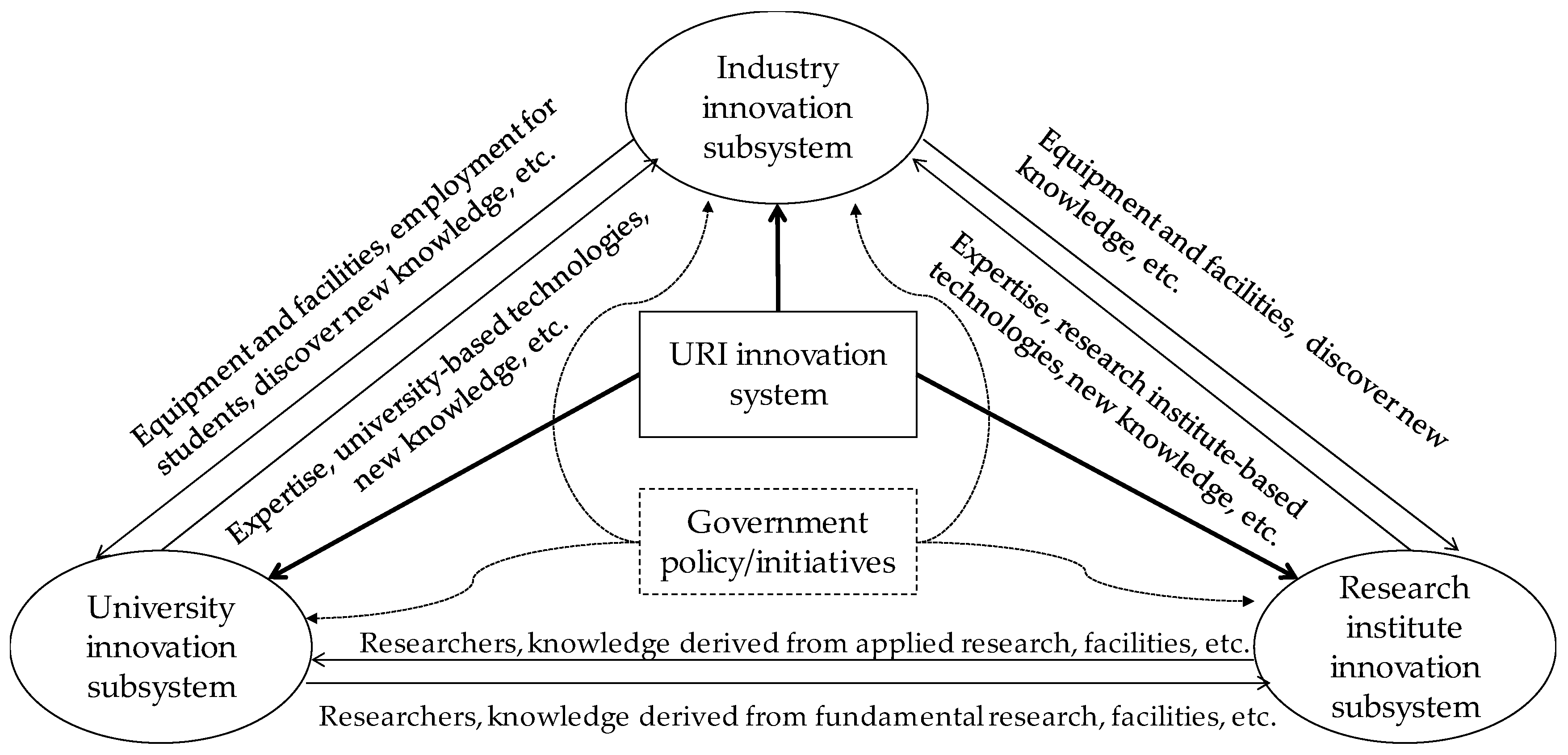
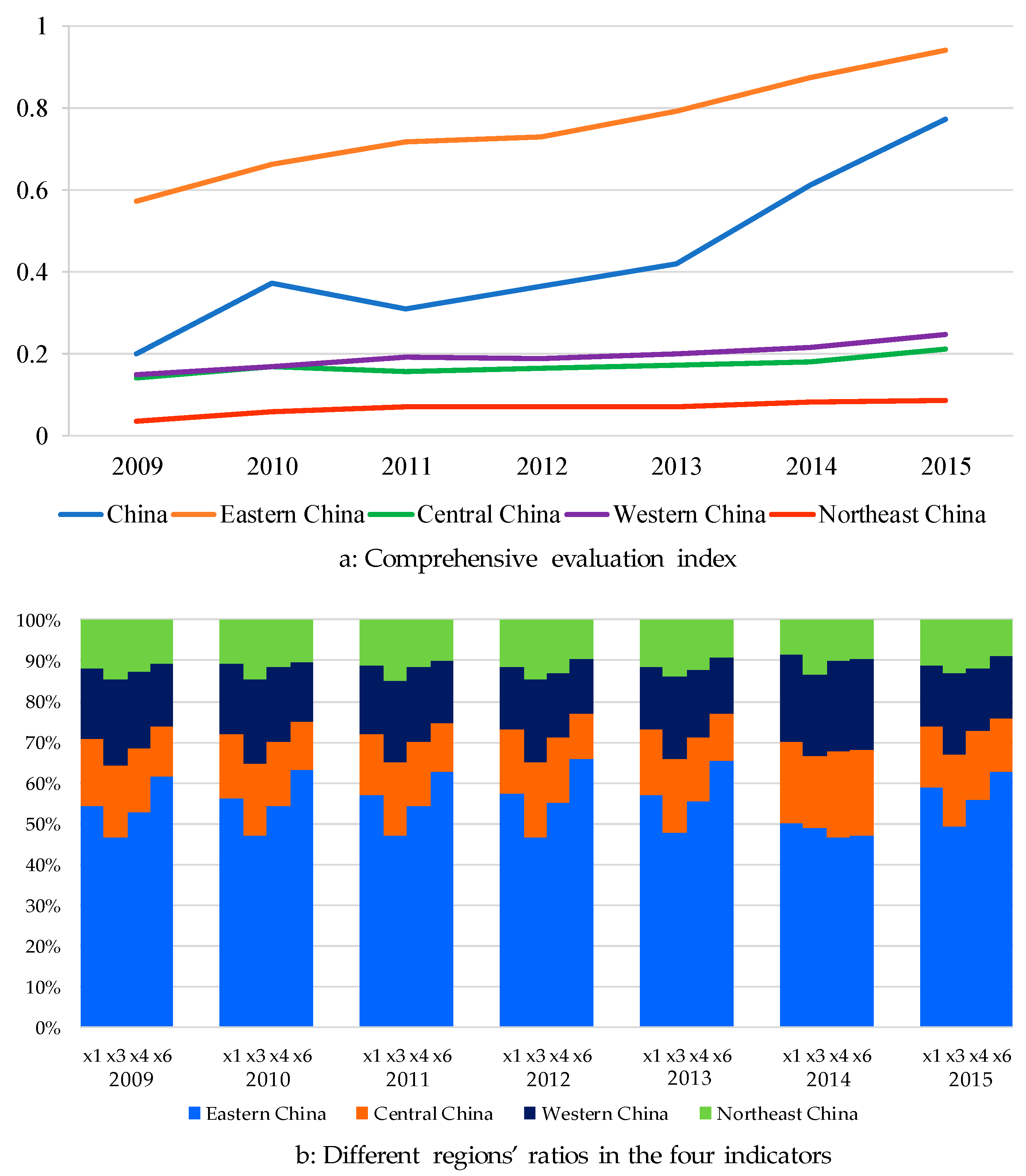
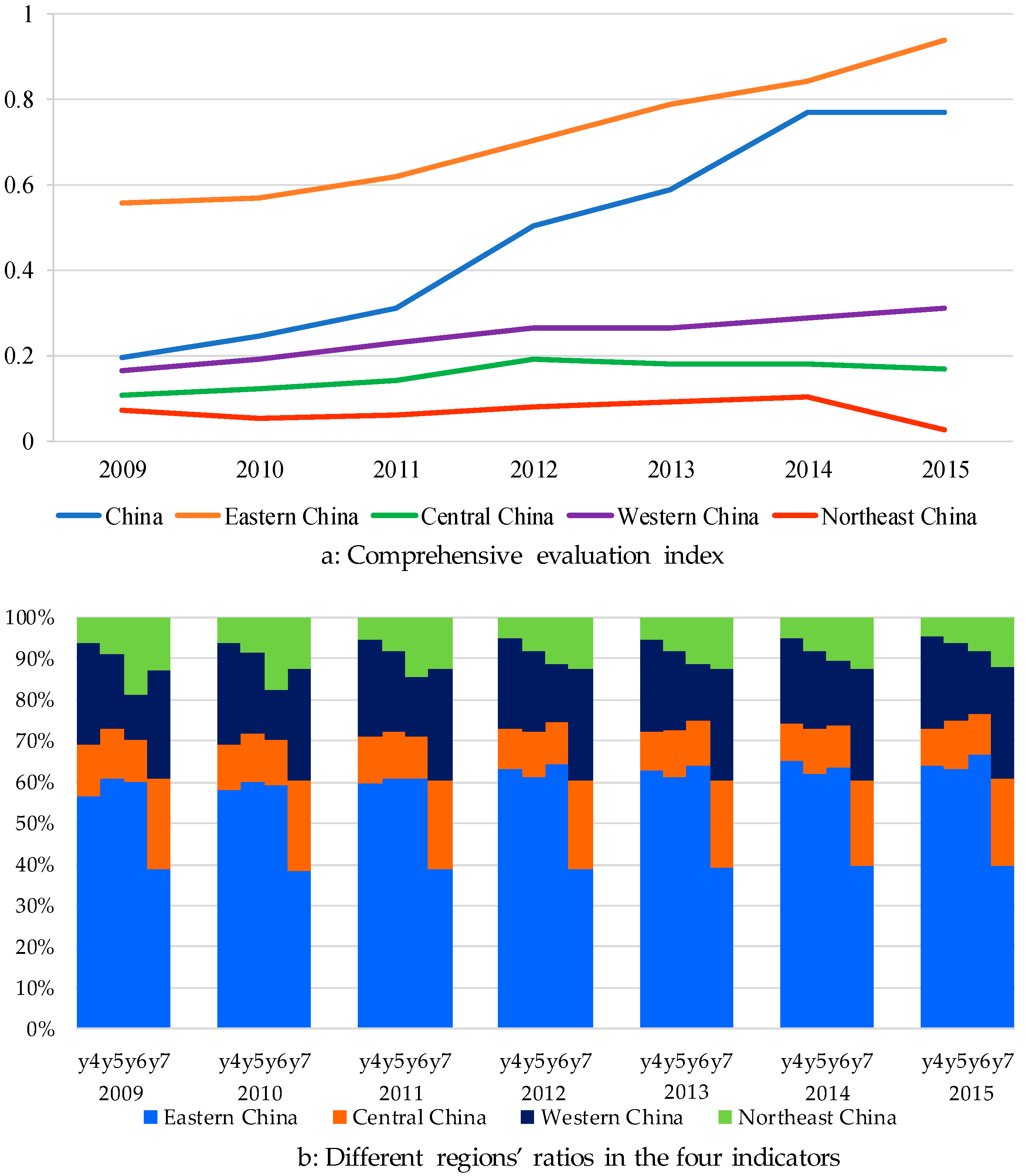
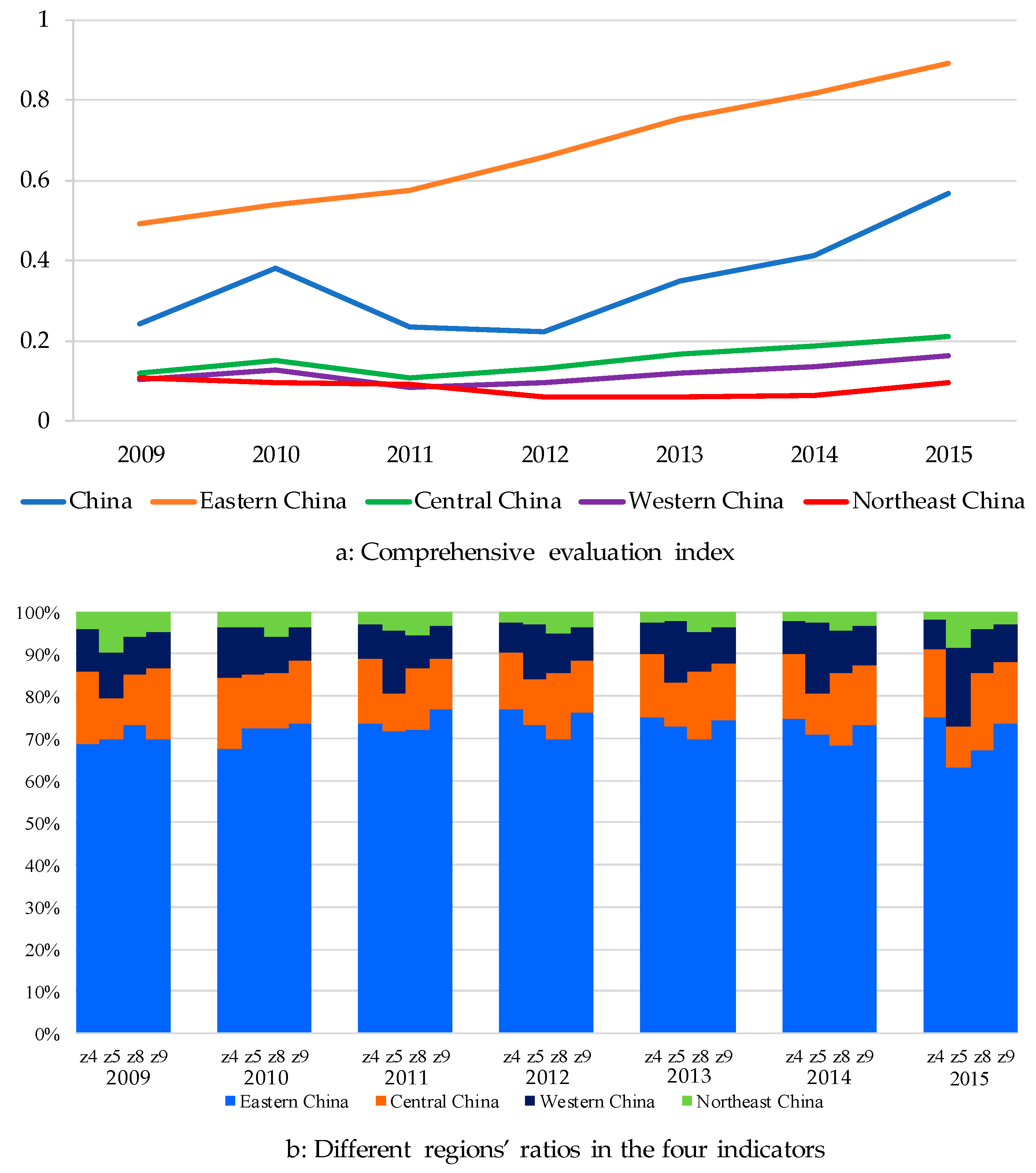
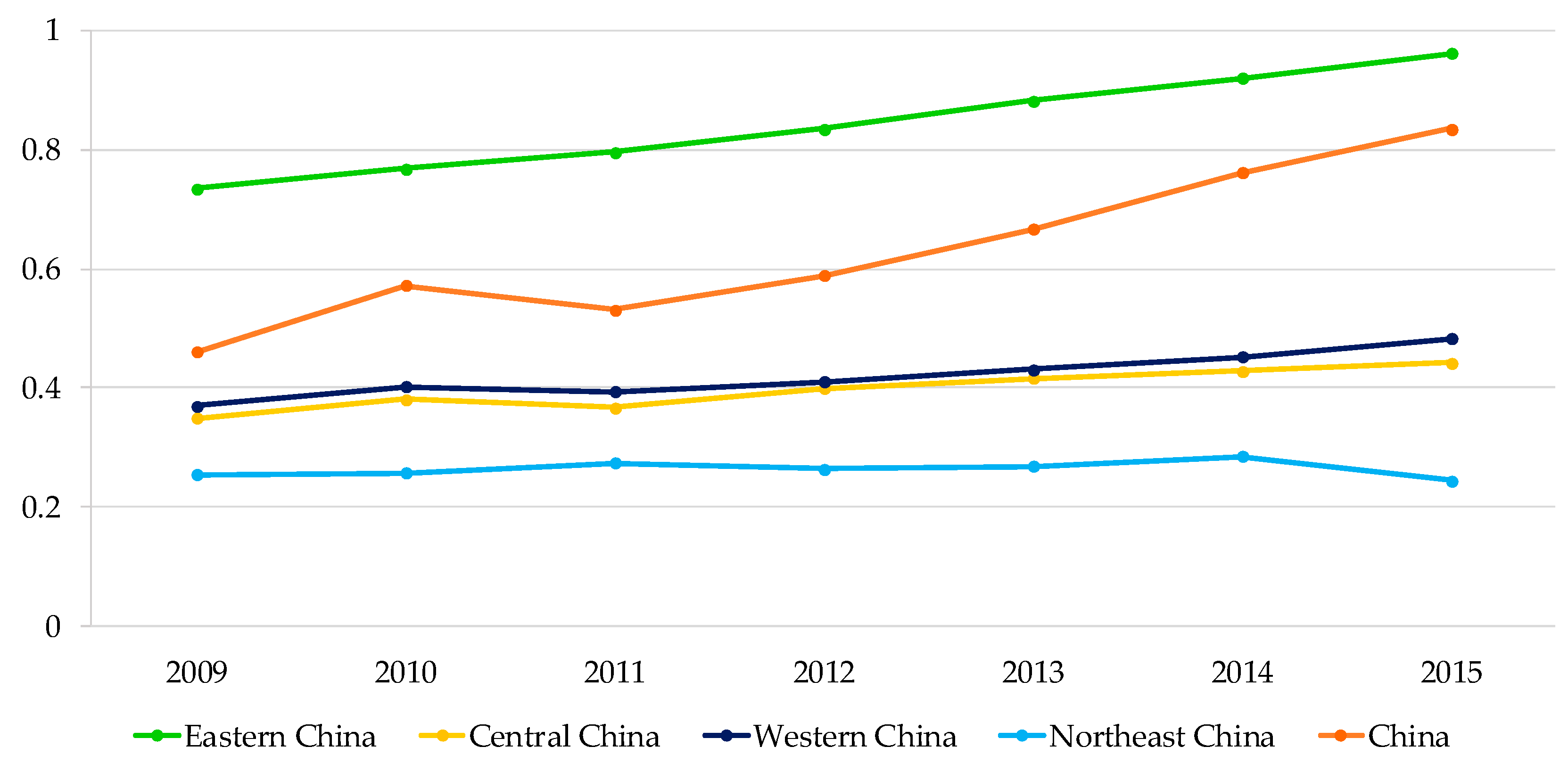

| Subsystem | Evaluation Indicator | Unit | Weight |
|---|---|---|---|
| University innovation | Research and Development (R&D) internal expenditure x1 | 10,000 yuan | 0.199 |
| Proportion of enterprises funds in R&D internal expenditure x2 | % | 0.004 | |
| Researchers input x3 | Persons*years | 0.086 | |
| R&D project funding x4 | 10,000 yuan | 0.204 | |
| The number of the published scientific papers x5 | 0.085 | ||
| The number of patents x6 | 0.268 | ||
| The number of universities x7 | 0.038 | ||
| The number of the scientific publishing works x8 | 0.116 | ||
| Research institute innovation | R&D internal expenditure y1 | 10,000 yuan | 0.121 |
| Proportion of enterprises funds in R&D internal expenditure y2 | % | 0.083 | |
| Researchers input y3 | Persons*years | 0.119 | |
| R&D project funding y4 | 10,000 yuan | 0.132 | |
| The number of published scientific papers y5 | 0.136 | ||
| The number of patents y6 | 0.158 | ||
| The number of research institutes y7 | 0.139 | ||
| The number of scientific publishing works y8 | 0.112 | ||
| Industry innovation | R&D internal expenditure z1 | 10,000 yuan | 0.105 |
| Proportion of government funds in R&D internal expenditure z2 | % | 0.030 | |
| Proportion of new products’ R&D expenditure in main business income z3 | % | 0.000 | |
| The number of enterprises’ R&D institutes z4 | 0.181 | ||
| Expenditures on acquiring external technology z5 | 10,000 yuan | 0.115 | |
| The number of R&D employees z6 | 0.104 | ||
| R&D project funding z7 | 10,000 yuan | 0.113 | |
| The number of high-tech enterprises z8 | 0.121 | ||
| The number of patents z9 | 0.177 | ||
| Proportion of new products’ sales revenue in main business income z10 | % | 0.018 | |
| Proportion of high-tech enterprises’ income in main business income z11 | % | 0.038 |
| Primary Classifications | Secondary Classifications | Tertiary Classifications | ||
|---|---|---|---|---|
| Balanced development (BD) (Acceptable interval) | 0.8 < D ≤ 1 | Superiorly BD | m = min (CEIU, CEIR, CEII) | Superiorly BD with m lagged |
| CEIU = CEIR = CEII | Superiorly BD with synchronous development of the tripartite | |||
| 0.6 < D ≤ 0.8 | Favorably BD | m = min (CEIU, CEIR, CEII) | Favorably BD with m lagged | |
| CEIU = CEIR = CEII | Favorably BD with synchronous development of the tripartite | |||
| Transitional development (Transitional interval) | 0.5 < D ≤ 0.6 | Barely BD | m = min (CEIU, CEIR, CEII) | Barely BD with m lagged |
| CEIU = CEIR = CEII | Barely BD with synchronous development of the tripartite | |||
| 0.4 < D ≤ 0.5 | Slightly UBD | m = min (CEIU, CEIR, CEII) | Slightly BD with m lagged | |
| CEIU = CEIR = CEII | Slightly BD with synchronous development of the tripartite | |||
| Unbalanced development (UBD) (Unacceptable interval) | 0.2 < D ≤ 0.4 | Moderately UBD | m = min (CEIU, CEIR, CEII) | Moderately UBD with m lagged |
| CEIU = CEIR = CEII | Moderately UBD with synchronous development of the tripartite | |||
| 0 < D ≤ 0.2 | Seriously UBD | m = min (CEIU, CEIR, CEII) | Seriously UBD with m lagged | |
| CEIU = CEIR = CEII | Seriously UBD with synchronous development of the tripartite | |||
| Provinces | 2009 | 2010 | 2011 | 2012 | 2013 | 2014 | 2015 |
|---|---|---|---|---|---|---|---|
| Eastern China | |||||||
| Beijing (BJ) | 0.585 | 0.596 | 0.622 | 0.650 | 0.688 | 0.707 | 0.726 |
| Jiangsu (JS) | 0.513 | 0.513 | 0.553 | 0.592 | 0.628 | 0.657 | 0.670 |
| Shanghai (SH) | 0.462 | 0.478 | 0.502 | 0.527 | 0.546 | 0.562 | 0.620 |
| Guangdong (GD) | 0.464 | 0.480 | 0.494 | 0.507 | 0.532 | 0.549 | 0.601 |
| Shandong (SD) | 0.416 | 0.423 | 0.443 | 0.456 | 0.477 | 0.497 | 0.509 |
| Zhejiang (ZJ) | 0.387 | 0.397 | 0.432 | 0.432 | 0.454 | 0.461 | 0.499 |
| Tianjin (TJ) | 0.293 | 0.303 | 0.308 | 0.320 | 0.341 | 0.353 | 0.367 |
| Hebei (HB) | 0.264 | 0.285 | 0.293 | 0.300 | 0.311 | 0.341 | 0.327 |
| Fujian (FJ) | 0.249 | 0.254 | 0.265 | 0.270 | 0.278 | 0.288 | 0.307 |
| Hainan (HAN) | 0.120 | 0.120 | 0.117 | 0.119 | 0.133 | 0.137 | 0.132 |
| Central China | |||||||
| Hubei (HUB) | 0.358 | 0.377 | 0.376 | 0.399 | 0.415 | 0.430 | 0.446 |
| Anhui (AH) | 0.284 | 0.290 | 0.307 | 0.332 | 0.354 | 0.368 | 0.386 |
| Hunan (HUN) | 0.309 | 0.312 | 0.337 | 0.370 | 0.374 | 0.377 | 0.375 |
| Henan (HN) | 0.298 | 0.308 | 0.325 | 0.326 | 0.346 | 0.358 | 0.374 |
| Shanxi (SX) | 0.246 | 0.249 | 0.250 | 0.260 | 0.267 | 0.260 | 0.261 |
| Jiangxi (JX) | 0.231 | 0.246 | 0.239 | 0.242 | 0.254 | 0.261 | 0.278 |
| Western China | |||||||
| Sichuan (SC) | 0.353 | 0.366 | 0.383 | 0.405 | 0.408 | 0.427 | 0.445 |
| Shaanxi (SNX) | 0.325 | 0.328 | 0.350 | 0.354 | 0.381 | 0.396 | 0.408 |
| Guangxi (GX) | 0.232 | 0.244 | 0.247 | 0.241 | 0.248 | 0.252 | 0.260 |
| Chongqing (CQ) | 0.216 | 0.228 | 0.303 | 0.272 | 0.284 | 0.292 | 0.292 |
| Yunnan (YN) | 0.227 | 0.221 | 0.223 | 0.232 | 0.237 | 0.250 | 0.272 |
| Gansu (GS) | 0.211 | 0.230 | 0.220 | 0.224 | 0.224 | 0.228 | 0.227 |
| Guizhou (GZ) | 0.179 | 0.213 | 0.198 | 0.188 | 0.214 | 0.227 | 0.213 |
| Inner Mongolia (NMG) | 0.173 | 0.186 | 0.213 | 0.189 | 0.233 | 0.219 | 0.216 |
| Xinjiang (XJ) | 0.155 | 0.157 | 0.159 | 0.166 | 0.179 | 0.179 | 0.182 |
| Xizang (XZ) | 0.063 | 0.086 | 0.059 | 0.053 | 0.053 | 0.069 | 0.061 |
| Qinghai (QH) | 0.106 | 0.116 | 0.094 | 0.102 | 0.115 | 0.114 | 0.088 |
| Ningxia (NX) | 0.091 | 0.089 | 0.093 | 0.122 | 0.101 | 0.111 | 0.126 |
| Northeast China | |||||||
| Liaoning (LN) | 0.381 | 0.366 | 0.386 | 0.386 | 0.406 | 0.410 | 0.391 |
| Jilin (JL) | 0.283 | 0.270 | 0.274 | 0.278 | 0.277 | 0.289 | 0.318 |
| Heilongjiang (HLJ) | 0.304 | 0.305 | 0.305 | 0.316 | 0.323 | 0.327 | 0.333 |
 Superiorly BD; ■ Favorably BD; ■ Barely BD; ■ Slightly UBD; ■ Moderately UBD; ■ Seriously UBD.
Superiorly BD; ■ Favorably BD; ■ Barely BD; ■ Slightly UBD; ■ Moderately UBD; ■ Seriously UBD.© 2018 by the authors. Licensee MDPI, Basel, Switzerland. This article is an open access article distributed under the terms and conditions of the Creative Commons Attribution (CC BY) license (http://creativecommons.org/licenses/by/4.0/).
Share and Cite
Li, J.; Fang, H.; Fang, S.; Siddika, S.E. Investigation of the Relationship among University–Research Institute–Industry Innovations Using a Coupling Coordination Degree Model. Sustainability 2018, 10, 1954. https://doi.org/10.3390/su10061954
Li J, Fang H, Fang S, Siddika SE. Investigation of the Relationship among University–Research Institute–Industry Innovations Using a Coupling Coordination Degree Model. Sustainability. 2018; 10(6):1954. https://doi.org/10.3390/su10061954
Chicago/Turabian StyleLi, Jing, Hong Fang, Siran Fang, and Sultana Easmin Siddika. 2018. "Investigation of the Relationship among University–Research Institute–Industry Innovations Using a Coupling Coordination Degree Model" Sustainability 10, no. 6: 1954. https://doi.org/10.3390/su10061954






